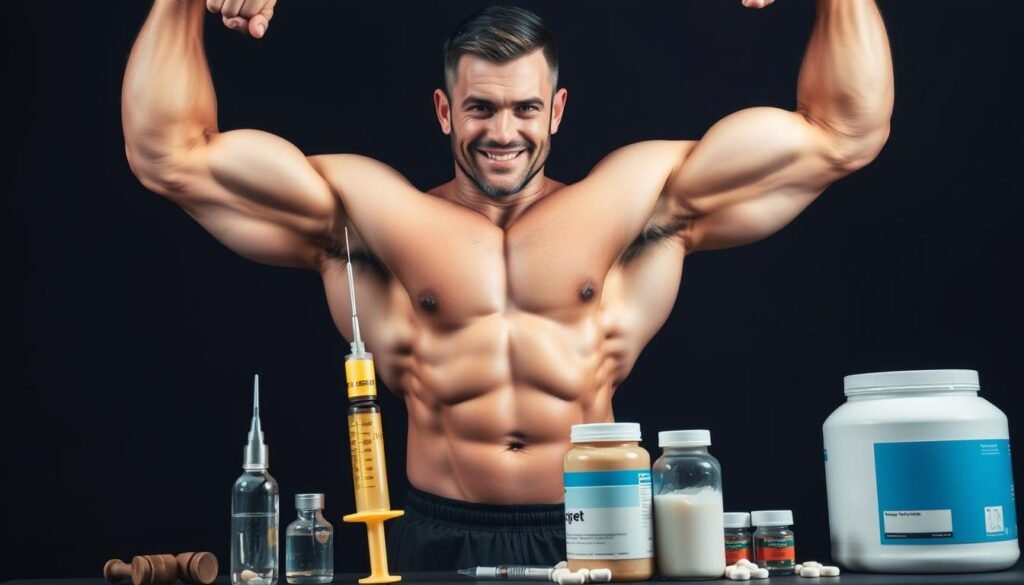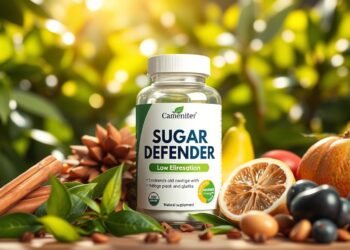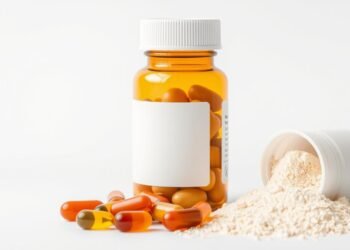For athletes and bodybuilders, managing insulin is key to growing muscles. Insulin helps store nutrients and build proteins. This is important for muscles to heal and grow.
Studies show insulin sensitivity is vital for building lean muscle. A study found people with more muscle had better insulin sensitivity. This is true for men, who had twice the sensitivity of those with less muscle.
Managing insulin does more than help muscles grow. It also lowers the risk of getting type 2 diabetes. If you have pre-diabetes, not acting can increase your risk by 70%. So, balancing diet, exercise, and insulin is important for health and performance.
Key Takeaways
- Effective insulin management is key for muscle growth.
- Insulin helps store nutrients and build proteins for muscle recovery.
- More muscle means better insulin sensitivity.
- Men with more muscle have better insulin sensitivity.
- Good insulin management lowers the risk of type 2 diabetes.
Understanding Insulin’s Role in Muscle Growth
Insulin is key in muscle growth. It helps control blood sugar and gets nutrients into muscle cells. This helps muscles repair and grow.
What is Insulin?
Insulin comes from the pancreas. It helps cells use glucose, a key energy source from carbs. Healthy blood sugar is 80–130 mg/dl before meals and 180 mg/dl or less after meals.
There are different types of insulin. Short-acting insulin starts working fast and lasts a few hours. Intermediate-acting insulin takes longer to start but lasts longer.
How Insulin Affects Muscle Synthesis
Insulin and muscle growth are connected. It helps bring amino acids into muscle cells for protein making. Low insulin doses don’t affect protein making much.
But, intermediate doses help make more protein and break down less. A 2006 study showed insulin boosts protein making by 157%.
Insulin and Nutrient Timing
When you eat matters for muscle growth. Eating after working out is best. It helps refill glycogen and make more protein.
Bodybuilders often take insulin after workouts. This helps them stay in a growth state. It also helps muscles recover and grow better.
| Insulin Dose | Phenylalanine Delivery | Muscle Protein Synthesis | Muscle Protein Breakdown |
|---|---|---|---|
| Low Dose (LD) | -9 ± 18% | 16 ± 26% | No significant change |
| Intermediate Dose (ID) | +63 ± 38% | +157 ± 54% | No change |
| High Dose (HD) | +12 ± 11% | +9 ± 19% | -17 ± 15% |
Key Factors That Influence Insulin Levels
Understanding how to improve insulin for muscle growth is key. Diet, exercise, sleep, and stress all play big roles. They help make your body better at using insulin, which is good for muscles.
Diet Composition
What you eat affects your insulin levels a lot. Foods high in carbs, proteins, and fats do different things to insulin. Eating foods that raise blood sugar slowly is better.
Whole grains, legumes, and veggies are great. They help with muscle growth. Proteins are also important for fixing and growing muscles.
Exercise and Insulin Sensitivity
Exercise is great for making your body better at using insulin. Both cardio and strength training help. A study showed that not doing strength training can lead to insulin problems.
It found that not doing strength training at all was even worse. This shows how important it is for muscle growth.
Sleep and Stress Impact
Getting enough sleep and managing stress are also important. Not enough sleep and too much stress can mess with your hormones. This can make your body not use insulin well.
Try to sleep 7-9 hours each night. It helps your body recover and grow muscles. Stress can also hurt your insulin use. Try to relax with meditation, yoga, or hobbies.
In short, eating right, exercising, and sleeping well are key. They help your body use insulin better. This is good for growing muscles and staying healthy.
Best Foods for Optimizing Insulin Response
Managing insulin control for muscle development is key for athletes and fitness fans. The right foods can greatly affect how your body handles insulin. This helps keep blood sugar levels balanced and boosts muscle growth. Here are some important food groups to think about:
Low Glycemic Index Foods
Foods with a low glycemic index (GI) are great for better insulin sensitivity and muscle growth. These include many fruits, veggies, whole grains, and legumes. They release glucose slowly, avoiding big blood sugar spikes and insulin jumps.
Eating these foods keeps your energy steady. This is good for your health and workout performance.
High-Protein Options
High-quality proteins are vital for muscle repair and growth. Choose grass-fed beef, lean poultry, fish, and plant-based proteins like lentils and quinoa. Adding carbs with protein slows down blood sugar rises, leading to a stable insulin response.
This balanced eating helps with insulin sensitivity and muscle hypertrophy.
Healthy Fats and Their Benefits
Healthy fats are also important in your diet. Avocados, nuts, seeds, and olive oil are good sources. They provide essential fatty acids and help manage insulin levels.
Healthy fats make you feel full and help control blood sugar. Eating a balanced diet with these fats fights insulin resistance and supports metabolic health.
Following these dietary tips helps you optimize insulin response, improve muscle growth, and boost overall health.
Meal Timing Strategies to Maximize Insulin
Good meal timing can really help with *lean muscle building and insulin regulation*. Plan your meals before and after working out. This helps improve *insulin sensitivity* and supports muscle growth.
Pre-Workout Nutrition
Eating a high-protein meal before working out gets your body ready. Foods high in protein fuel your muscles and raise insulin levels. Good pre-workout meals include:
- Grilled chicken breast
- Greek yogurt with berries
- Protein shakes
These foods prepare your body for the workout and keep blood sugar levels good.
Post-Workout Recovery Meals
After working out, eating carbs helps repair muscles and manage insulin. Meals rich in carbs after your workout boost *insulin sensitivity*. Try these:
- Brown rice with lean beef
- Quinoa salad with mixed vegetables
- Whole-grain bread with peanut butter
These foods refill glycogen and help muscles recover, using insulin well.
Importance of Regular Meal Intervals
Having meals at regular times keeps insulin levels stable. This gives your muscles a steady energy supply. Studies show *insulin sensitivity* gets better with regular meal times. Here are some tips:
- Intermittent fasting, like early time-restricted feeding (eTRF), improves insulin sensitivity.
- Eating in a 6-hour window optimizes glucose, lipid, and energy metabolism.
- Not eating late at night fits better with your body’s natural rhythm, helping with *insulin regulation*.
| Meal Timing Strategy | Benefit | Example |
|---|---|---|
| Pre-Workout High-Protein | Increase in lean muscle mass and insulin regulation | Grilled chicken breast or protein shake |
| Post-Workout Carb-Rich | Enhanced recovery and insulin sensitivity | Brown rice with lean beef or whole-grain bread with peanut butter |
| Regular Meal Intervals | Stable insulin levels and consistent energy supply | eTRF with meals before 3 PM |
Supplements That Support Insulin Management
Good insulin management for lean muscle gains needs more than just food and exercise. It also needs special supplements. These help make your body use insulin better and use nutrients well. Here are some top supplements for this.
Creatine and Insulin Sensitivity
Creatine is famous for boosting sports performance. But it also helps with insulin sensitivity. Research shows it makes muscles take up glucose better.
This is key for growing muscles with insulin help. Creatine helps control blood sugar and supports building lean muscle.
BCAAs for Muscle Repair
Branched-Chain Amino Acids (BCAAs) are vital for fixing and growing muscles. They boost muscle protein making and help keep muscles during dieting. BCAAs make sure insulin works right, helping muscles grow and preventing loss.
Fiber and Its Role in Insulin Control
Fiber is key for keeping insulin levels steady. It slows down carb digestion and glucose release. This keeps insulin levels stable, which is vital for maximizing muscle gains with insulin management.
Eating foods high in fiber or taking supplements helps control insulin long-term. It also boosts your metabolic health.
The Connection Between Insulin Sensitivity and Muscle Gains
Looking into how insulin sensitivity and muscle growth connect is key. It shows how our bodies react to food and exercise. People who keep their insulin levels in check can grow more muscle and stay healthy.

Signs of Poor Insulin Sensitivity
Poor insulin sensitivity shows up in many ways. You might feel tired all the time, always hungry, and can’t lose weight. A study found that men who didn’t lift weights were more likely to get insulin resistance.
Regular exercise is vital for keeping insulin levels right. It helps grow muscle too.
How to Improve Insulin Sensitivity
To get better insulin sensitivity, you need to do a few things. Start with resistance training and eat foods that don’t raise blood sugar fast. Also, try to lose some body fat.
Even small changes can make a big difference. Studies show that losing weight and doing strength training can really help. It can even make your muscles bigger by 8.9% on average.
The Benefits of Increased Sensitivity
Being more sensitive to insulin has many good effects. It helps your body use nutrients better, which is great for muscle growth and recovery. A study found that older Hispanic adults with diabetes got better muscle quality and less insulin resistance from lifting weights.
These benefits aren’t just for muscles. They also help your metabolism and lower disease risks.
| Study Parameter | Strength Training Group | Control Group | P-Value |
|---|---|---|---|
| Muscle Quality Improvement | 28±3 | -4±2 | |
| Type I Muscle Fiber Area (µm²) | 860±252 | -164±290 | 0.04 |
| Type II Muscle Fiber Area (µm²) | 720±285 | -130±336 | 0.04 |
| Reduction in Insulin Resistance (HOMA-IR) | -0.7 | 0.8 | 0.05 |
The Importance of Hydration
Drinking enough water is key for muscle growth. Water and salts help our body work right. They help us absorb nutrients and grow lean muscle.
Water’s Role in Nutrient Transport
Water makes up about 76% of our muscles. It’s very important for muscle health. Water helps carry nutrients and oxygen to our muscles.
Drinking enough water helps our muscles grow. It makes them stronger too.
Electrolytes and Insulin Function
Electrolytes like sodium, potassium, and magnesium keep our muscles working right. They help insulin move glucose into our muscles. This is important for muscle growth.
Keeping electrolytes balanced helps us have more energy. It also helps us not get too hungry. Sodium and potassium keep the right balance of fluids in our body.
Combining Training with Diet for Best Results
To get the best results, you need to mix resistance training, cardio, and a good diet. How well you work out and what you eat affects your body. This part talks about how to mix training and diet for the best results.
Resistance Training and Insulin
Resistance training is key for better insulin sensitivity and muscle hypertrophy. Doing regular workouts helps grow muscle and take in more glucose. Studies show eating 1.1 to 1.4 grams of protein per pound of body weight daily is important.
People who did resistance training lost fat and got leaner. This helped them reach their body goals.
Cardiovascular Exercise’s Impact
Cardio helps with heart health and losing fat. This makes insulin response for muscle growth better. Studies found that cycling at 70% of peak heart rate improved insulin sensitivity by 25-30%.
Doing both resistance and cardio workouts is best for losing weight and fat.
Balancing Training and Recovery
It’s important to balance how hard you work out and how much you rest. Good sleep and managing stress help muscles grow. Training three times a week for 60-75 minutes each session is a good plan.
| Factor | Impact on Insulin Sensitivity | Impact on Muscle Hypertrophy |
|---|---|---|
| Resistance Training | Significant improvement | Increases muscle mass |
| Cardiovascular Exercise | Improves cardiovascular health and insulin response | Facilitates fat loss |
| Balanced Diet | Optimizes nutrient absorption | Aids in muscle repair and growth |
| Proper Recovery | Enhances overall insulin effectiveness | Supports muscle recovery |
These factors show why a complete plan of training and diet is key. It helps with insulin response for muscle growth and better health.
Common Mistakes in Insulin Management
Getting the most out of insulin for muscle gain needs careful steps. Steer clear of common errors to use insulin well for building lean muscle and keeping insulin levels right.

Overlooking Meal Composition
Many miss the meal’s role. It’s key to have the right mix of proteins, fats, and carbs. Studies show that the right carbs help manage insulin better.
Ignoring Rest and Recovery
Rest and recovery are often overlooked. Not taking insulin as planned can raise blood sugar too high. It’s important to check blood sugar often, even when feeling good.
Lack of Consistency in Training
Being consistent in workouts and insulin use is vital. Missing workouts can mess up muscle gain. Using a glucose monitor helps plan workouts better. Staying regular in workouts helps keep insulin levels right for muscle growth.
A table summarizing statistics can highlight the significant pitfalls in insulin management for lean muscle building:
| Factor | Error | Impact |
|---|---|---|
| Meal Composition | Ignoring low-glycemic foods | Increased fat mass, reduced muscle gains |
| Rest and Recovery | Skipping insulin doses | High blood sugar levels, poor muscle recovery |
| Consistency in Training | Irregular workouts | Reduced insulin sensitivity, hindered muscle growth |
Real-Life Examples of Successful Insulin Management
More people are using smart insulin management for muscle growth. They share their success stories. These stories show how insulin sensitivity helps build muscle.
Case Studies of Athletes
Top athletes manage insulin well to grow muscle. For example, Jay Cutler, a famous bodybuilder, adjusts his diet and workouts to improve insulin sensitivity. This helps him build muscle and avoid fat.
Transformations through Diet and Training
Many people have changed their bodies through diet and exercise. Dwayne “The Rock” Johnson is a great example. He eats foods that don’t raise blood sugar quickly and lots of protein and healthy fats. This helps him stay muscular.
Lessons Learned from Experts
Experts say managing insulin is key for muscle and health. Dr. John Ivy says exercise and a balanced diet improve insulin sensitivity. He suggests combining cardio and strength training to manage diabetes better.
These examples show that smart insulin management is doable and helps build lean muscle.










